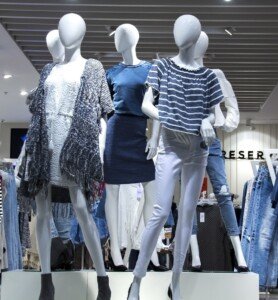
Super thin mannequins have been around for at least 40 years; why NOW are they causing eating disorders?
Or is it just easier to blame a prop and ignore the real factors behind anorexia nervosa?
Let’s give credit where credit is due when it comes to what fuels an eating disorder:
For example, a dysfunctional family in which a young girl feels pressured by her controlling parents to excel and be perfect.
• She is stripped of having any control over her life.
• She is genetically hardwired to be a perfectionist.
• Cultural norms and the entertainment industry can be predisposing factors.
But mannequins in stores hardly define society’s expectations of what a female should look like.
Many kids and teens simply conclude that mannequins are merely props that a store uses to hang clothes on.
A mannequin will not “cause” an eating disorder.
“The cause of anorexia nervosa is a complex issue, and there is no specific cause (yet determined) of anorexia nervosa,” says Linda Centeno, PhD, clinical psychologist, and assistant director of the Koch Center in NJ that specializes in eating disorder treatment.
“We do not know why we all are exposed to ‘thin’ in the media from young ages, and most individuals never go on to develop anorexia nervosa.
“Most experts agree that an eating disorder is not about weight. Instead, anorexia arises due to a combination of personality, genetics and environment (such as culture, social and family situations).”
Many anorexics were NOT overweight prior to the initial development of their disorder; in fact, a naturally thin girl can develop anorexia nervosa.
It makes more sense that if we have two girls, both 15 and 5’3”, and one weighs 200 and the other weighs 100 (naturally), that the heavy girl will be the one relishing the mannequin’s body, not the thin girl.

Shutterstock/Nomad_Soul
“Individuals with anorexia generally display obsessive behaviors with respect to food and dieting and often exhibit an extreme drive for perfectionism,” explains Dr. Centeno.
“Being able to control one’s body and food intake can substitute for wanting to be able to control the other ‘real’ difficult issues in one’s life (such as relationship issues, trauma, family problems, other stressors, etc.).”
Kids will recognize mannequins for what they are: a hybrid woman and hanger, made as thin as possible to save on manufacturing costs. At least that’s what I thought growing up.
Imagine the extra costs if every size 00 mannequin was made with more material to appear like a size 8 or even 6.
It may not seem like a lot more material per single mannequin, but multiply that out by thousands and thousands of mannequins made by the factory.
It’s also logical that stores order them as thin as possible so that they can then cram as many as possible up on display boxes.
This benefits the manufacturer: More mannequins purchased means more profit!
To translate this to society’s expectations of a woman’s body is just way beyond the moon.
Go ahead, read online forums for people with anorexia nervosa.
The home lives that many describe they come from will unnerve you.
It’s way too easy to include store mannequins as a contributing factor.
Even Hollywood’s biggest female stars don’t look like store mannequins.
In fact, most Hollywood celebrities and recording artists do NOT have ultra-thin bodies.
Take a look at Lily-Rose Depp below. She has admitted to having anorexia nervosa and makes Jennifer Aniston — who’s been accused of being too thin — look plump!

Lily-Rose is as thin as a mannequin. But how many Hollywood stars are built like her?
Okay, we have some who come close, such as Angelina Jolie and Victoria Beckham, and there are a handful of other contemporary starlets who are “scary skinny.”
But they are just a small fraction of ALL the big-name film and TV stars and recording acts out there.
Some of the biggest stars have heavy thighs: Beyoncé, Rihanna and Kim Kardashian.
If teens and young women are so desperate to emulate these people, why aren’t we blaming teenage obesity on Beyoncé, Rihanna, Kim, Adele and Melissa McCarthy?
Name one Victoria’s Secret model who looks like a mannequin or Lily-Rose Depp.
Mannequin Research
Dr. Eric Robinson and his team from the University of Liverpool’s Institute of Psychology, Health and Society believe that store mannequins are encouraging unrealistic body ideals.
Dr. Robinson’s study was published in the Journal of Eating Disorders, and notes that the average size of the male mannequins in his research were significantly bigger than the average female’s body – and that only a small number of male mannequins looked underweight.
This seems to blow the money-saving, space-saving explanations out the window.
On the other hand, imagine a man strolling through a clothing department and seeing six-foot male mannequins with bodies that in real life would equate to 120 pounds.
Shoppers are heavily influenced by what they see. He is more likely to buy attire that hangs on a more realistic looking plastic body.
So why doesn’t this concept apply to female shoppers?
Here’s a plausible explanation: Men do not equate masculinity with super thin male physiques, since masculinity brings to mind strength and power.
However, femininity CAN be associated with twig-thin mannequins since feminity is NOT associated with brawniness and physical force.
Think of butterflies, flowers and pretty snowflakes vs. trucks, horses and chainsaws.
Dr. Robinson says in his report, “We became interested in this topic [ultra-thin mannequins] after seeing some news report about members of the general public noticing that some mannequins in fashion stores were disturbingly thin.”
Dr. Robinson’s team surveyed two high streets in the United Kingdom, finding that the size of female mannequins represented an extremely underweight woman.
Growing up, I’d see these ridiculously thin mannequins all the time at May Company, Sears, JCPenney and in little shops in the mall.
Nobody in that generation wanted to look like a plastic humanoid with clothes on.
And I doubt that anyone in this generation wants to look like Lily-Rose Depp.
“Because ultra-thin ideals encourage the development of body image problems in young people,” says Dr. Robinson’s paper, “we need to change the environment to reduce emphasis on the value of extreme thinness.”
According to Dr. Robinson’s (and many others’) line of logic, if all female mannequins were built like Beyoncé or MMA fighter Ronda Rousy, we’d have thousands of teen girls and young women striving to achieve heavy thighs and an overall curvy look or muscular physique.

 Dr. Centeno
Dr. Centeno























